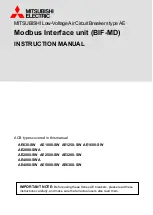
44
Operation and maintenance of
IZM low voltage air circuit breakers
MOELLER
www.moeller.net/de/support
10/09 AWB1230-1605
Effective October 2009
Figure 66. IZM Nameplate Information
Manual operation functional test
Charge the breaker mechanism springs either using the charging
handle or the motor operator. Press the ON pushbutton to close
the breaker manually and verify closing by noting the state of the
indicating flag. Charge the breaker mechanism springs either
using the charging handle or the motor operator. If using the motor
operator, disconnect power to it to prevent automatic recharging.
Press the OFF pushbutton to manually open the breaker. Press the
ON pushbutton to manually close the breaker. Is the breaker
closed? Press the OFF pushbutton to manually open the breaker.
Is the breaker open? Repeat this entire described test procedure
three times.
Electrical operation functional test
This test procedure is based on the assumption that the breaker is
equipped with optional shunt trip and spring release accessories. If
one accessory is missing, substitute the manual button to replace
the accessory’s function.
Charge the breaker mechanism springs either using the charging
handle or the motor operator. Close the breaker by applying
rated voltage to the spring release accessory and verify closing
by noting the state of the indicating flag. Charge the breaker
mechanism springs either using the charging handle or the motor
operator. If using the motor operator, disconnect power to it to
prevent automatic recharging. Open the breaker by applying rated
voltage to the shunt trip accessory. Close the breaker using the
spring release accessory. Is the breaker closed? Open the breaker
using the shunt trip accessory. Is the breaker open? Repeat this
entire described test procedure three times.
1. G.O.#: It: Seq:
2. Cust. P.O.:
3. Date of Manufacture
1
2
3
Trip unit overload functional test
This test uses the Digitrip 1150 self test function, the Digitrip
Test Kit, or the hand-held IZM Functional Test Kit. Review test kit
instructions for the trip unit. Instruction leaflet, Section 1.2 or 1.3
applies for instantaneous test procedures or Paragraph 5.2.1
“1150 Self Testing, Trip Mode” in the trip unit instruction leaflet
AWB1230-1608.
Charge the breaker mechanism springs either using the charging
handle or the motor operator. Press the ON pushbutton to close
the breaker manually and verify closing by noting the state of the
indicating flag. Charge the breaker mechanism springs either using
the charging handle or the motor operator. If using the motor
operator, disconnect power to it to prevent automatic recharging.
Trip the breaker with a trip unit test. Verify that the trip indicator pop-
out button (if so equipped) is “out” and then reset it. Press the ON
pushbutton to manually close the breaker. Is the breaker closed?
Trip the breaker with a trip unit test. Verify that the trip indicator pop-
out button (if so equipped) is “out” and then reset it. Repeat this
entire described test procedure three times. Reset the blinking
red cause-of-trip LED on the trip unit by pressing the Reset/Battery
Test pushbutton.
Arc chute inspection
When a circuit breaker experiences a high-level fault or during
regularly scheduled maintenance periods, the circuit breaker’s
arc chutes and arc chambers should be inspected for any kind of
damage or dirt. Be especially alert for signs of significant erosion
of the V-shaped plates inside the arc chute.
Arc chutes fit inside the arc chambers and down over the primary
contacts. Each arc chute is held in place by one top-inserted screw
(
). Begin by removing the arc chute screws and all three
arc chutes. Turn each arc chute upside down to visually inspect the
inside (
).
Since the arc chutes are removed, this is an ideal time to inspect
primary contacts for wear using the circuit breaker’s contact wear
indicators. The details associated with primary contact inspection
are presented in the next paragraph.
Figure 67. Top Rear View of Circuit Breaker with One Arc
Chute Removed
Arc Chute Removed
Baffled Cover
Arc Chamber









































